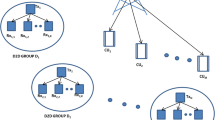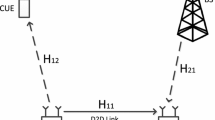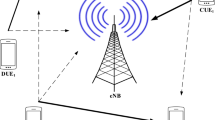Abstract
In this study, device-to-device (D2D) communication is exploited to adopt the proximity transmission among two nearby devices. The base station in this scenario transmits both information and energy to both D2D users to deploy wireless power transfer feature in green communications. In addition, to enhance the overall spectrum utilization of considered system, downlink non-orthogonal multiple access (NOMA) network is considered to evaluate performance in such network. In particular, a downlink from the base station (BS) equipping multiple antennas is designed to robust performance. We further determine the worse case of considered NOMA at the receiver in cellular network as considering impact of imperfect successive interference cancellation (SIC). A two-user downlink NOMA scenario is considered, where a far user directly communicates with the BS without SIC, whereas a near user is assigned to serve D2D link with imperfects on SIC. The ergodic capacity of D2D NOMA is further analyzed under both perfect and imperfect SIC. The performance gap among two considered users in D2D NOMA network is demonstrated through simulation and analysis.









Similar content being viewed by others
References
Dai, L., Wang, B., Yuan, Y., Han, S., Chih-Lin, I., & Wang, Z. (2015). Nonorthogonal multiple access for 5G: Solutions, challenges, opportunities, and future research trends. IEEE Communications Magazine, 53(9), 74–81.
Zhao, N., et al. (2019). Joint trajectory and precoding optimization for UAV-assisted NOMA networks. IEEE Transactions on Communications, 67(5), 3723–3735.
Ding, Z., Lei, X., Karagiannidis, G. K., Schober, R., Yuan, J., & Bhargava, V. (2017). A survey on non-orthogonal multiple access for 5G networks: Research challenges and future trends. IEEE Journal on Selected Areas in Communications, 35(10), 2181–2195.
Islam, S. M. R., Avazov, N., Dobre, O. A., & Kwak, K.-S. (2017). Power-domain non-orthogonal multiple access (NOMA) in 5G systems: Potentials and challenges. IEEE Communications Surveys and Tutorials, 19(2), 721–742.
Islam, S. M. R., Zeng, M., & Dobre, O. A. (2017). NOMA in 5G systems: Exciting possibilities for enhancing spectral efficiency. IEEE 5G Tech Focus, 1(2), 1–6.
Dinh-Thuan Do, H.-S., Nguyen, M. V., & Nguyen, T.-S. (2017). Wireless powered relaying networks under imperfect channel state information: System performance and optimal policy for instantaneous rate. Radioengineering, 26(3), 869–877.
Nguyen, X.-X., & Do, D.-T. (2017). Optimal power allocation and throughput performance of full-duplex DF relaying networks with wireless power transfer-aware channel. EURASIP Journal on Wireless Communications and Networking, 2017, 152.
Nguyen, K.-T., Do, D.-T., Nguyen, X.-X., Nguyen, N.-T., & Ha, D.-H. (2015). Wireless information and power transfer for full duplex relaying networks: Performance analysis. In Proceedings of recent advances in electrical engineering and related sciences (AETA 2015) (pp. 53–62). Hanoi: HCMC.
Nguyen, X.-X., & Do, D.-T. (2017). Maximum harvested energy policy in full-duplex relaying networks with SWIPT. International Journal of Communication Systems, 30(17), e3359.
Zhao, N., Yu, F. R., Sun, H., & Li, M. (2016). Adaptive power allocation schemes for spectrum sharing in interference-alignment-based cognitive radio networks. IEEE Transactions on Vehicular Technology, 65(5), 3700–3714.
Do, D.-T. (2016). Energy-aware two-way relaying networks under imperfect hardware: Optimal throughput design and analysis. Telecommunication Systems, 62(2), 449–459.
Nguyen, T.-L., & Do, D.-T. (2018). Exploiting impacts of intercell interference on SWIPT-assisted non-orthogonal multiple access. Wireless Communications and Mobile Computing, 2018, 12.
Do, D.-T., & Le, C.-B. (2018). Application of NOMA in wireless system with wireless power transfer scheme: Outage and ergodic capacity performance analysis. Sensors, 18(10), 3501.
Van Dinh-Thuan Do, M.-S., Nguyen, T.-A. H., & Voznak, M. (2019). NOMA-assisted multiple access scheme for IoT deployment: Relay selection model and secrecy performance improvement. Sensors, 19(3), 736.
Mumtaz, S., Huq, K. M. S., & Rodriguez, J. (2014). Direct mobile-to-mobile communication: Paradigm for 5G. IEEE Wireless Communications, 21(5), 14–23.
Doppler, K., Rinne, M., Wijting, C., Ribeiro, C. B., & Hugl, K. (2009). Device-to-device communication as an underlay to LTE-advanced networks. IEEE Communications Magazine, 47(12), 42–49.
Lei, L., Zhong, Z., Lin, C., & Shen, X. (2012). Operator controlled deviceto-device communications in LTE-advanced networks. IEEE Wireless Communications, 19(3), 96–104.
Asadi, A., & Mancuso, V. (2017). Network-assisted outband D2D-clustering in 5G cellular networks: Theory and practice. IEEE Transactions on Mobile Computing, 16(8), 2246–2259.
Tseng, H.-W., Yu, Y.-J., Wu, B.-S., Kuo, C.-F., & Chen, P.-S. (May 2017). A resource allocation scheme for device-to-device communication over ultra-dense 5G cellular networks. In Proceedings of international conference on applied innovation (ICASI) (pp. 80–83).
Ma, R., Chang, Y.-J., Chen, H.-H., & Chiu, C.-Y. (2017). On relay selection schemes for relay-assisted D2D communications in LTE-A systems. IEEE Transactions on Vehicular Technology, 66(9), 8303–8314.
Tehrani, M. N., Uysal, M., & Yanikomeroglu, H. (2014). Device-to-device communication in 5G cellular networks: Challenges, solutions, and future directions. IEEE Communications Magazine, 52(5), 86–92.
Lien, S.-Y., Chien, C.-C., Liu, G. S.-T., Tsai, H.-L., Li, R., & Wang, Y. J. (2016). Enhanced LTE device-to-device proximity services. IEEE Communications Magazine, 54(12), 174–182.
Osseiran, A., et al. (2014). Scenarios for 5G mobile and wireless communications: The vision of the METIS project. IEEE Communications Magazine, 52(5), 26–35.
Tullberg, H., et al. (2016). The METIS 5G system concept: Meeting the 5G requirements. IEEE Communications Magazine, 54(12), 132–139.
Madani, N., & Sodagari, S. (2018). Performance analysis of non-orthogonal multiple access with underlaid device-to-device communication. IEEE Access, 6, 39820–39826.
Zheng, H., Hou, S., Li, H., Song, Z., & Hao, Y. (2018). Power allocation and user clustering for uplink MC-NOMA in D2D underlaid cellular networks. IEEE Wireless Communications Letters, 7(6), 1030–1033.
Diao, X., Zheng, J., Wu, Y., & Cai, Y. (2019). Joint computing resource, power, and channel allocations for D2D-assisted and NOMA-based mobile edge computing. IEEE Access, 7, 9243–9257.
Zhao, N., Cao, Y., Yu, F. R., Chen, Y., Jin, M., & Leung, V. C. M. (2018). Artificial noise assisted secure interference networks with wireless power transfer. IEEE Transactions on Vehicular Technology, 67(2), 1087–1098.
Hedayati, M., & Kim, I.-M. (2018). On the performance of NOMA in the two-user SWIPT system. IEEE Transactions on Vehicular Technology, 67(11), 11258–11263.
Zhang, H., et al. (2018). Energy-efficient resource allocation in NOMA heterogeneous networks with energy harvesting. In Proceedings of 2018 IEEE global communications conference (GLOBECOM) (pp. 206–212).
Choi, M., Han, D., & Moon, J. (2018). Bi-directional cooperative NOMA without full CSIT. IEEE Transactions on Wireless Communications, 17(11), 7515–7527.
Do, D.-T., & Van Nguyen, M.-S. (2019). Device-to-device transmission modes in NOMA network with and without wireless power transfer. Computer Communications, 139, 67–77.
Gradshteyn, S., & Ryzhik, I. M. (2000). Table of integrals, series and products (6th ed.). New York, NY: Academic Press.
Author information
Authors and Affiliations
Corresponding author
Additional information
Publisher's Note
Springer Nature remains neutral with regard to jurisdictional claims in published maps and institutional affiliations.
Appendices
Appendix 1
Proof of Proposition 1
Based on definition, the outage probability for the first user in the D2D NOMA network can be obtained by examining each component as follows
where \(\theta =\frac{{{\varepsilon }_{1}}}{\rho \left( 1-\alpha \right) \left( {{\varTheta }_{1}}-{{\varepsilon }_{1}}{{\varTheta }_{2}} \right) }\).
Then, the computation of \( A_2 \) can be given by
where \(\upsilon =\frac{{{\varepsilon }_{1}}}{\eta \rho \alpha }\).
Unfortunately, it is very hard to achieve the closed-form (39), the approximate form can be obtained. By motivated by generalized incomplete gamma, using interesting result of \(\int \limits _{0}^{x}{{{t}^{\alpha -1}}{{e}^{-at-b{{t}^{-1}}}}=}{{a}^{-\alpha }}\gamma \left( \alpha ,ax;ab \right) \) satisfying condition \(a>0\). As a result, \({{A}_{2,2}}\) can be given by
Plugging (40) into (39), \({{A}_{2,1}}\) is expressed
Replacing (41) into (38), \({{A}_{2}}\) can be written by
Combining (42) and (37) into (14) \(P_{{\text {cN}},1}\) it can be exhibited final result
It complete the proof.□
Appendix 2
Proof of Proposition 2
We first calculate \({{C}_{1}}\) as
where \(\chi =\max \left( \frac{{{\varepsilon }_{2}}}{\rho \left( 1-\alpha \right) \left( {{\varTheta }_{2}}-{{\varTheta }_{1}}\mu {{\varepsilon }_{2}} \right) },\theta \right) \)
Next, the closed-form of is more complicated and it can be formulated by
where \({{C}_{2,1}}=\int \limits _{0}^{\frac{{{\varepsilon }_{2}}}{\rho \left( 1-\alpha \right) \left( {{\varTheta }_{2}}-{{\varTheta }_{1}}\mu {{\varepsilon }_{2}} \right) }}{{{f}_{{{\left| {{h}_{n,2}} \right| }^{2}}}}\left( x \right) dx},\)\({{C}_{2,2}}=\int \limits _{0}^{\theta }{{{f}_{{{\left| {{h}_{n,2}} \right| }^{2}}}}\left( y \right) {{F}_{{{\left| {{g}_{k,2}} \right| }^{2}}}}\left( \frac{\upsilon }{y} \right) dy}\), \({{C}_{2,3}}=\int \limits _{0}^{\varDelta }{{{f}_{{{\left| {{h}_{n,2}} \right| }^{2}}}}\left( z \right) {{F}_{{{\left| {{g}_{k,2}} \right| }^{2}}}}\left( \frac{\upsilon }{z} \right) dz}\), \(\varDelta =\min \left( \frac{{{\varepsilon }_{2}}}{\rho \left( 1-\alpha \right) \left( {{\varTheta }_{2}}-{{\varTheta }_{1}}\mu {{\varepsilon }_{2}} \right) },\theta \right) \)
It can be solved by examining each component. We have following results
It is noted that \({{C}_{2,2}}={{B}_{2,2}}\)
Plugging (46), (47) and (21) into (45) the new expression of \({{C}_{2}}\) can be rewritten as
We continue to replace (44) and (48) into (26), \(P_{{\text {cN}},2}^{{\text {ipSIC}}}\) can be expressed by
It is the end of the proof.□
Rights and permissions
About this article
Cite this article
Le, CB., Do, DT. Joint evaluation of imperfect SIC and fixed power allocation scheme for wireless powered D2D-NOMA networks with multiple antennas at base station. Wireless Netw 25, 5069–5081 (2019). https://doi.org/10.1007/s11276-019-02116-1
Published:
Issue Date:
DOI: https://doi.org/10.1007/s11276-019-02116-1




